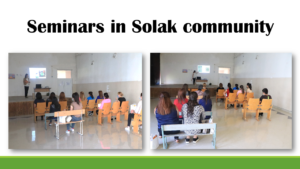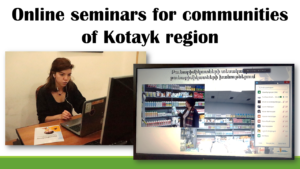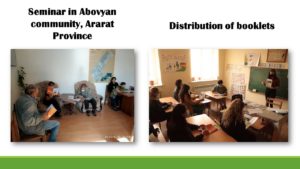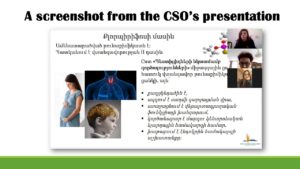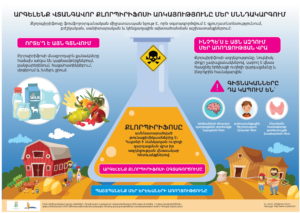Main objectives:
- Contribute to protection of human health and the environment through joining to coalitions for global ban on Chlorpyrifos
- Promote safe alternatives to Chlorpyrifos in particular women family farmers in Kotayk and Ararat provinces
Activities:
- Creation of national CSO coalition advancing global ban of Chlorpyrifos
1.1 Organizing working group of interested stakeholders and experts for advancing chemical safety policies
A working group of 8 members was established, including stakeholders and experts from the following NGOs and educational institutions: National Agrarian Academy of Armenia Lecturer (Naira Gasparyan, professor and internship coordinator), Association for Sustainable Human Development NGO (Karine Danielyan, president), Aarhus Center (Silva Ayvazyan, Coordinator), “Public Awareness and Monitoring Center” NGO (Chakryan Marie, president), Ministry of Agriculture (Karine Yesayan Former employee), and Armenian Women for Health and Healthy Environment” NGO (Elena Manvelyan, President and Knarik Grigoryan, Enviromental health expert).
During composing of the letters to ministries working group members offered their knowledge and experience in the field in order to advance overall chemical safety policies in Armenia.
1.2 Brief assessment of the current usage of Chlorpyrifos in Armenia
An 11 pages long document-study was prepared on the current usage of Chlorpyrifos in Armenia under the name The situation in Armenia related to the use of chlorpyrifos and its impact – Ruraldaf. During the assessment mainly data from The Food Safety Inspection Body of the Republic of Armenia (ref. https://www.gov.am/en/bodies-under-government/207/ )and statistics from the National Center for Disease Control (ref. https://ncdc.am/) were used. The assessment was later used during the seminar with CSOs and Roundtable discussion, in the form of presentation.
1.3 National CSOs Appeal to decision-makers calling for Chorpirifos banning
Through consultation from different NGOs and working group members letters were sent to the following governing bodies. Ministry of Economy, Ministry of Health and Ministry of Environment, and the Food Safety Inspection Body. Official reply letters were received from all the above bodies.
In our letters to abovementioned ministries and governing bodies we expressed our concern over the negative and harmful effects of Chlorpyrifos on farmers and especially children. We urged them to review the registration permit for Chlorpyrifos, include it in the list of prohibited substances, prohibit its import, take action to stop its usage, and at the same time develop recommendations on alternative pest control measures.
The responses from the governmental bodies indicated that plant protection professionals (practical farmers) mention the benefits of Chlorpyrifos-containing herbicides in combating pests compared to its alternatives. According to them, the ban would cause economic damage to land users and overall to the whole agricultural sector in the RA.
They also noted that there is currently no legal basis for the ban of Chlorpyrifos-containing pesticides, and that these grounds are established and governed by the Rotterdam Convention.
- Awareness-raising campaign on Chlorpyrifos
2.1 Organizing capacity building training for CSOs advancing ban of Chlorpyrifos and promotion of safe alternatives
A webinar was organized with representatives of 18 CSOs, such as: the Armenia Tree Project(ATP) charity organization, “Ajdahak” socio-ecological center, “Clean Goris” NGO, Yerevan Aarhus Center, “Tree of Life” NGO, “Public Awareness and Monitoring Center” NGO, Dalma-Sona Foundation, “Effective Governance and Community Development” NGO, Hrazdan Aarhus Center, “Territorial Development and Research Center” NGO, Armenia association of social entrepreneurs, “Syrian-Armenians Union” NGO.
For many participants the name Chlorpyrifos was very new and many suggested organizing more in-person seminars for communities, in order to educate and raise awareness on the issue.
2.2 Organizing Round Table discussion with the specialists of agriculture from the Ministry of Economy and Food Safety Inspection Body regarding the national strategy of HHPs usage, in particular chlorpyrifos, in Armenia
Due to covid19 restrictions, a webinar was organized, via ZOOM. During the webinar, we did a small presentation of our research on Chlorpyrifos usage, poisoning and import in Armenia and discussed further steps that should be done in order to facilitate the ban of Chlorpyrifos and usage of alternatives. Representatives from the Ministry of Economy (Ms. Inessa Avagyan, Head of Food Safety Department) and Food Safety Inspection Body (Mr. Arthur Nikoyan, Head of the Department of Phytosanitary) were very impressed by the research and work done, and highlighted that there are 3 important ways in which the issue can be combated: applying to international organizations, awareness raising and integrated management.
2.3 Sharing the project results through the meetings, webinars, webpage, etc
- Meetings and webinars with community members.
Overall 8 seminars were conducted, of which 5 in communities of Solak, Goght, Qaxsi (Kotayk province) Lusagyguh (Armavir province) and Abovyan community (Ararat province). Solak (29 participants), Goght (10 participants), Qaxsi (17 participants), Abovyan (10 participants), Lusagyugh (9 participants). 3 seminars were conducted online due to the COVID situation in Armenia. During the seminars booklets were distributed. The majority of the participants were women from farmer families.
- Dissemination of information materials (booklet, poster, article) online
Due to the COVID situation in Armenia the only way to successfully distribute information was through online platforms, such as Facebook and websites. This allowed the information to be delivered to wide range of audiences and provoke broader discussion among people. Information was distributed overall to 47 communities, organizations and groups, in total to 50 594 people. The audience was from 8 provinces: Aragatsotn (Vardenut, Ashtakarak communities), Ararat (Baghramyan, Taperakan, Ditak, Berkanush, Burastan, Aygavan, Khachpar and Abovyan communities), Armavir (Apaga, Lusagyguh, Jrarat, Margara and Armavir communities), Kotayk (Solak, Teghenik and Goght communities), Lori (Stepanavan community), Shirak (Gyumri, Bagravan and Dzitanqov communities), Syunik (Svarants community) and Yerevan. Additionally, the information was distributed in Facebook groups and pages of different environmental organizations and community discussion groups such as “Organic Armenia “Agricultural Association NGO, Life safety in emergencies, GMO free Armenia, Davtyan Farms, Bari farm (organic agriculture and tourism), “Armenia Tree Project” Charity foundation Eco leaders group, Vanand, Biosophia, Third nature NGO, and groups of Biology and Chemistry teachers.
During the online dissemination interesting discussions were provoked, as an example in one group-discussion people contemplated whether it is better to use Chlorpyrifos and have good harvest, or use alternative methods and have healthy harvest, in which case they protect people, their children and the environment. While opinions differed, we believe that communication on this matter is the first step towards awareness raising and fostering change.
- Article on Chlorpyrifos on ruraldaf webpage – https://ruraldaf.am/332-2/
- Dissemination of information materials (booklet poster) to 4 communities in province in Kotayk (Alapars, Goght, Qaxsi and Solak), Lusagyugh community of Armavir province, and Berkanush community of Ararat province. Total of 128 booklets were distributed in the 6 communities to farmer families
- Interview on the usage of Chlorpyrifos in Armenia, its danger and steps done towards banning it in Armenia, 1TV News, 20.03.2021, 13։49-17։38min – https://www.youtube.com/watch?v=mTk7CmWriUo (17 566 people viewed as of 29.03.2021)
Publications:
- Leaflet “Chlorpyrifos; a pesticide damaging children’s brain”
- The situation in Armenia related to the use of chlorpyrifos and its impact – Ruraldaf
- Poster “Ban the existence of Chlorpyrifos in our food”
Below are the photos from the project implementation
